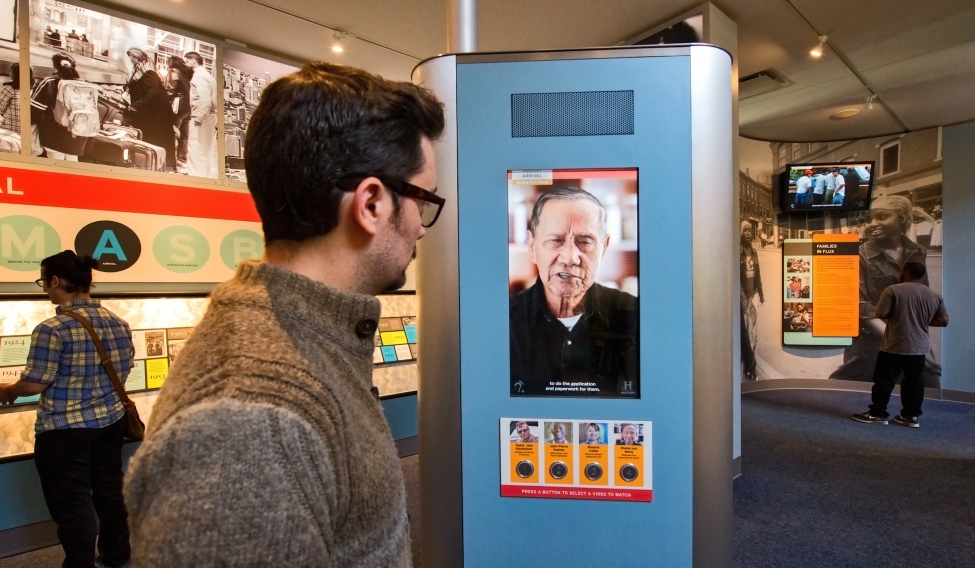ESI Design Tech Perspective: Reflecting on the New Ellis Island Exhibits
Posted May 19, 2015

Some eight years ago, ESI Design began designing the Peopling of America Center exhibits for what has newly become the National Immigration Museum on Ellis Island. Super storm Sandy damage set progress back a few years, and the post-Ellis Island galleries officially open their doors today. Seeing these final areas of the exhibit installed after all these years offers us an opportunity to reflect on the design and technology choices we made at the outset, and to evaluate how we approached an important aspect of our design challenge: create an interactive, accessible experience that integrates technology robust enough to host over 20 million people over the center’s first 10+ years.
First, we focused on content. A multi-disciplinary team of designers here at ESI Design created an immersive exhibit exploring the past 200,000 years of human migration. There are two distinct, but related, exhibits: Journeys: The Peopling of America—1550s to1890 and Journeys: New Eras of Immigration—1954 to Present. We designed both exhibits around the same narrative structure, based on five commons stages of an immigrant’s journey: Leaving, Making the Trip, Arrival, Struggle and Survival and Building a Nation. Each of the Journeys exhibits is composed of five distinct gallery areas expressing these stages of the immigrant experience in the context of the two respective time periods.
Then, ESI Design employed four key principles in making technology choices that would last, maximize access to the experience, and help visitors enter into the immigrant experience at different points in time:
- Use technology specific to the story being told: The Pre-Ellis island exhibit takes place in a timeframe when the surviving personal stories can be found in the form of documents such as letters, journals or diaries—rather than video. Therefore, we chose primarily audio to primarily share these stories. On the other hand, “New Eras of Immigration” takes place in a media-rich time of video, broadcast media and photographs. So, the exhibit engages visitors through these very modes, relying much more on technology than in the pre-Ellis Island exhibit. The basic materials and acoustic design of the two spaces create a core differentiation that also closely relates to the subject matter and its place in history; the Pre-Ellis exhibit has been crafted of tile, steel and rough-hewn wood—traditional materials of the colonial era—while the more modern “New Eras” exhibit features carpeting, brushed aluminum, contoured lines that refer to air travel and construction materials typical of the ‘new age’ of immigration.
- Design individual exhibit technology as an integrated part of the larger experience: Each gallery features moments of real individuals’ experiences expressed within a larger, ambient environment. Audio thresholds in pre-Ellis exhibits as well as the audio-video Scenes of the Journey in “New Eras,” create a tempo and an ambient audio track unique to each of the 5 galleries. Within this sound-shaped environment, ‘story windows’ and ‘story kiosks’ tell real immigrant accounts though voices that have been carefully equalized and compressed to be clearly audible—whether by one person, a group or family, so that they can both listen to and have a conversation around the story they hear.
- Use robust technology: All audio and video is playing from solid-state single-purpose media players designed for 24×7 playback. A climate controlled equipment room with uninterruptible power supplies holds the exhibit hardware. The players are all networked to allow for remote monitoring, maintenance and upgrades. Industrial grade user-interface technology, such as switches and sensors, allow for many millions of triggers.
- Use technology to make the experience as accessible to as many people as possible: All audio pieces have induction loop technology hidden in them to broadcast directly to many assistive listening devices, which enables people with hearing impairments to access the full exhibit experience. All content also has open captioning. For people with visual disabilities, a full audio tour of all the exhibits includes visual descriptions.
By following these four principles, ESI designers were able to create an immersive space that leverages audio-visual technology to engage visitors in the many narratives of the immigrant’s journey. The stories are told in ways that engage multiple senses while being accessible to all.
A/V Technology Behind the Experience
At the heart of the Pre-Ellis island exhibit, Global Migration, is the “World Migration Globe,” featuring 4K interactive video displayed on a dual-HD projection globe (created by Arc Science). The globe’s special optics takes two HD projectors and edge-blends the images across the inside of a custom, rear-projection 5’ acrylic sphere.
Unseen to exhibit-goers, an inch of absorptive acoustic material applied to the back of every large, hard surface helps dull some of the reverberance of the space so that visitors can easily converse and still clearly hear the ambient audio.
Special mini-linear array speakers from TOA control the audio beam and help minimize audio spill. An amazing audio artist and engineer ran all the audio through multi-band equalization and dynamic range compression to help make the spoken work “pop” against the ambient sound. Audio that sounds great in the studio can often turn out to be unintelligible in a museum setting and needs to be adjusted on-site in this way.
Special focusable speakers were used in all the “Story Kiosks,” which gave us the ability to change the direction of the sound during installation. To sense a visitor’s proximity to the “Story Windows” and trigger the storytelling audio, we used microwave sensors, which also help minimize unnecessary ambient audio by using the visitor’s mass to absorb extraneous sound as they stand in front of the story window.


Join The Conversation